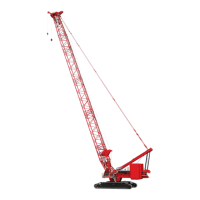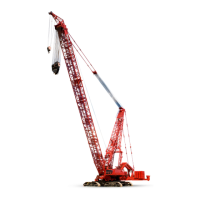Manitowoc Published 10-09-2020, Control # 259-06 5-31
MLC80A-1/MLC90A-1/MLC100A-1/MLC100-1 SERVICE/MAINTENANCE MANUAL HOISTS
Maintenance
At least once a week, inspect and test the A2B switches as
follows.
1. Lower the boom and jib onto blocking at ground level
and carefully inspect the following items.
a. Inspect each switch for freedom of movement.
b. Inspect each weight for freedom of movement on
the load line.
c. Inspect each weight, each chain, each shackle, and
each connecting pin for excessive or abnormal
wear. Make sure the cotter pins for the shackles are
installed and spread.
d. Inspect the entire length of the electric cables for
damage.
e. Make sure that the electric cables are clear of all
moving parts in the boom and jib and that the cables
are securely fastened to the boom and jib.
f. Make sure that all cables and terminating plugs are
securely fastened.
2. Test the block-up limit controls for proper operation with
the engine running using either of the following methods:
• Boom and Jib Lowered: Manually lift each weight—
one at a time. The corresponding load drum must
not operate in the up direction, and the boom/luffing
hoist must not operate in the down direction.
• Boom and Jib Raised: Slowly hoist each load block
and weight ball—one at a time—against the weight.
When the chain goes slack, the corresponding load
drum must stop hoisting, and the boom/luffing hoist
must not operate in the down direction.
WIRE ROPE INSPECTION AND
REPLACEMENT
The following information is from various wire rope
manufacturers and includes inspection, replacement, and
maintenance guidelines for wire rope as established by
ANSI/ASME B30.5 federal regulations and Manitowoc
Cranes.
Wire Rope Lubrication
Refer to the lube folio for lubrication techniques.
A high-quality wire rope lubricant is available from
Manitowoc Crane Care Lattice Team. Otherwise, consult
your wire rope supplier.
Maintain a Wire Rope Condition Report
Always keep a signed and dated periodic inspection report of
the wire rope’s condition on file. The report must cover all
inspection points discussed in this section. The information
in the reports can then be used to determine when a wire
rope should be replaced.
After initial loading of a new rope, measure and record its
diameter for comparison with future inspections. Measure
the rope’s diameter across the crowns of the strands so the
true diameter is measured (see Figure 5-22
).
Wire rope removed from service should be examined and a
corresponding report kept. This information can be used to
establish a relationship between visual inspection and the
rope’s actual internal condition at the time of its removal from
service. See Replacement Criteria for inspection guidelines.
Required Inspection Intervals
The frequency of wire rope inspection must be:
• Daily (see Daily Inspection on page 5-38
) and
• Yearly (at minimum) (see Periodic Comprehensive
Inspection on page 5-33)
Wire Rope Care and Replacement
Guidelines
• When replacing fixed-length wire rope assemblies (such
as pendants) having permanently attached end fittings,
CAUTION
Prevent Damage!
To prevent two-blocking from occurring, do not operate
the crane until cause for improper operation and all
hazardous conditions have been found and corrected.
CAUTION
Avoid Sheave Damage!
Use extreme care testing the block-up limit controls when
the boom and jib are raised. If the block-up limit control
fails to stop the load, immediately stop the load by moving
the drum control handle to OFF or by applying the drum
working brake. Otherwise, two-blocking may occur.
CAUTION
Prevent Wire Rope Damage!
Do not use grease to lubricate the wire rope. Grease will
not penetrate the rope properly and will build up in the
valleys between the wires and strands. This buildup will
inhibit rope inspection and could trap moisture in the
rope’s interior.
